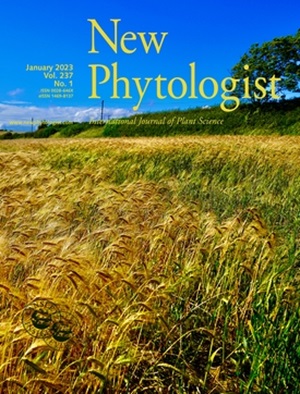除虫菊花开放的花盘小花夜间猝灭释放的胚芽烯 D 能诱导飞蛾在非寄主上产卵并提高授粉成功率
IF 8.3
1区 生物学
Q1 PLANT SCIENCES
引用次数: 0
摘要
摘要 最近的研究表明,夜间传粉昆虫对生态系统功能和粮食生产的重要性可能超过目前的认识。在此,我们描述了一项关于除虫菊(Tanacetum cinerariifolium)花授粉的农业现场研究。除虫菊在基因上是自交不亲和的,因此需要依赖授粉者才能结籽。我们的授粉昆虫排斥实验表明,夜行昆虫,尤其是飞蛾,对种子的结实率和质量有重大贡献。我们发现,最丰富的花挥发性物质--倍半萜(-)-锗烯 D(GD)是吸引夜蛾 Peridroma saucia 和 Helicoverpa armigera 的关键。锗烯 D 合成酶(GDS)基因的表达调控着特定 GD 在花朵中的产生和积累,与相关物种不同的是,这些花朵失去了夜间闭合的习性。我们确实观察到雌蛾也在除虫菊叶片和花梗上产卵,但发现只有一小部分卵孵化。幼虫发育严重受阻,很可能是由于除虫菊酯防御化合物的存在。这一利用型互惠关系的例子阻碍了蛾类授粉者的繁殖成功,并依赖于夜间的相互作用,我们将这一例子置于生态环境中,以解释其形成的原因。本文章由计算机程序翻译,如有差异,请以英文原文为准。
Nocturnal burst emissions of germacrene D from the open disk florets of pyrethrum flowers induce moths to oviposit on a nonhost and improve pollination success
Summary Recent studies show that nocturnal pollinators may be more important to ecosystem function and food production than is currently appreciated. Here, we describe an agricultural field study of pyrethrum (Tanacetum cinerariifolium ) flower pollination. Pyrethrum is genetically self‐incompatible and thus is reliant on pollinators for seed set. Our pollinator exclusion experiment showed that nocturnal insects, particularly moths, significantly contribute to seed set and quality. We discovered that the most abundant floral volatile, the sesquiterpene (−)‐germacrene D (GD), is key in attracting the noctuid moths Peridroma saucia and Helicoverpa armigera . Germacrene D synthase (GDS) gene expression regulates the specific GD production and accumulation in flowers, which, in contrast to related species, lose the habit of closing at night. We did observe that female moths also oviposited on pyrethrum leaves and flower peduncles, but found that only a small fraction of those eggs hatched. Larvae were severely stunted in development, most likely due to the presence of pyrethrin defense compounds. This example of exploitative mutualism, which blocks the reproductive success of the moth pollinator and depends on nocturnal interactions, is placed into an ecological context to explain why it may have developed.
求助全文
通过发布文献求助,成功后即可免费获取论文全文。
去求助
来源期刊

New Phytologist
生物-植物科学
自引率
5.30%
发文量
728
期刊介绍:
New Phytologist is an international electronic journal published 24 times a year. It is owned by the New Phytologist Foundation, a non-profit-making charitable organization dedicated to promoting plant science. The journal publishes excellent, novel, rigorous, and timely research and scholarship in plant science and its applications. The articles cover topics in five sections: Physiology & Development, Environment, Interaction, Evolution, and Transformative Plant Biotechnology. These sections encompass intracellular processes, global environmental change, and encourage cross-disciplinary approaches. The journal recognizes the use of techniques from molecular and cell biology, functional genomics, modeling, and system-based approaches in plant science. Abstracting and Indexing Information for New Phytologist includes Academic Search, AgBiotech News & Information, Agroforestry Abstracts, Biochemistry & Biophysics Citation Index, Botanical Pesticides, CAB Abstracts®, Environment Index, Global Health, and Plant Breeding Abstracts, and others.
 求助内容:
求助内容: 应助结果提醒方式:
应助结果提醒方式:


